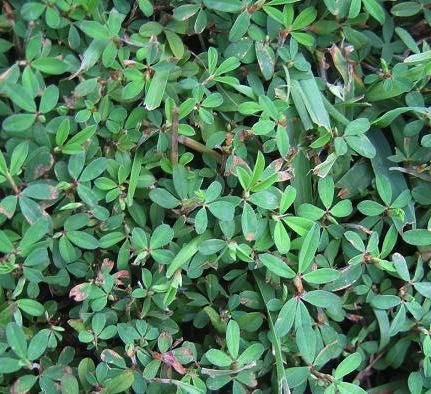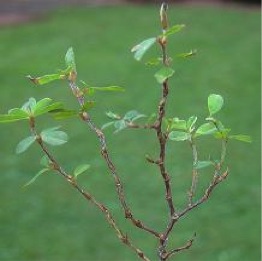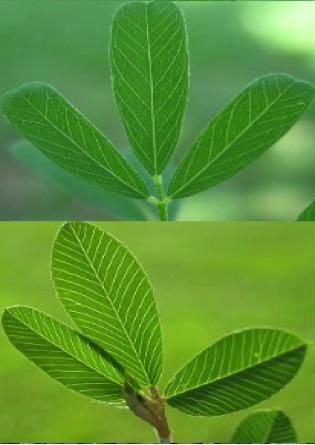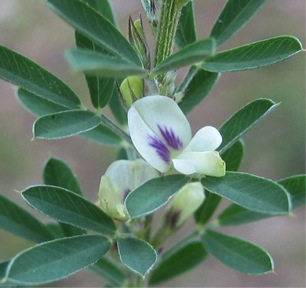Common lespedeza (Kummerowia striata (Thunb.) Schind syn. Lespedeza striata) is a freely branched, summer annual legume that is a problematic weed in lawns and other turf areas. Common lespedeza, also known as Japanese clover or annual lespedeza, has three smooth, oblong leaflets with parallel veins that are nearly perpendicular to the midvein (Figure 1). As common lespedeza matures, the stems harden and become woody, which is attributed to persistence and competition with turfgrasses in late summer (Figure 2). Flowers are pink to purple and present in the leaf axils. Other lespedeza species may also be found as weeds in turf, but common lespedeza is the primary species in Georgia.
 Figure 1. Common lespedeza in a centipedegrass lawn. Photo by P. McCullough.
Figure 1. Common lespedeza in a centipedegrass lawn. Photo by P. McCullough. Figure 2. Common lespedeza woody stems in late summer. Photo by P. McCullough
Figure 2. Common lespedeza woody stems in late summer. Photo by P. McCulloughKorean clover (Kummerowia stipulacea (Maxim.) Makino syn. Lespedeza stipulacea) is an annual species similar in growth and appearance to common lespedeza. Korean clover has the weediness potential of common lespedeza but is distinguished by antrorse hairs (angled upward on stems) while common lespedeza has retrorse stem hairs (angled downward on stems). Korean clover and common lespedeza are distributed across the eastern United States from Florida to New York and west to Nebraska and Texas.
Sericea lespedeza (Lespedeza cuneata Dum. Cours.) is a perennial species found in Georgia that may also be a weed of lawns and landscapes. Unlike common lespedeza, sericea lespedeza has an erect growth habit and may reach 5 feet in height if unmowed. In regularly maintained turfgrass, sericea lespedeza can be distinguished from common lespedeza by alternate, hairy leaves that are divided into three, oblong leaflets (Figure 3). Flowers are clustered and white with purple markings (Figure 4). The distribution of sericea lespedeza throughout the United States is similar to common lespedeza.
 Figure 3. Leaves of sericea lespedeza (top) and common lespedeza (bottom). Photos by P. McCullough.
Figure 3. Leaves of sericea lespedeza (top) and common lespedeza (bottom). Photos by P. McCullough. Figure 4. Sericea lespedeza leaves and flower. Photo by P. McCullough.
Figure 4. Sericea lespedeza leaves and flower. Photo by P. McCullough.Cultural Control
Several cultural practices can be used to control or reduce pressure of lespedeza species in turf. Deep and infrequent irrigation encourages turfgrass root development, which may improve the ability of desired grasses to compete with annual weeds in mixed stands. Withholding water until the desirable turfgrass species exhibits initial drought stress symptoms can help reduce soil moisture for potential weed infestations. Overwatering, especially in shady areas, may predispose the site to the invasion of lespedeza and other annual weeds.
Practices that promote soil compaction should be avoided to promote turfgrass growth and competition with weed populations. If possible, turf managers should redirect traffic away from stressed areas to help promote turfgrass recovery over thinned turf. Core aerifications should be conducted during active turf growth and favorable periods for quick recovery. Voids left in turf with exposed soil following aerification may permit weed invasion during periods of peak germination. For tall fescue, aerficiation should be timed in early fall, once the grass has recovered from summer stresses. Warm-season grasses should only be aerified during active growth to promote recovery. Early spring aerification may predispose lawns to summer annual weed establishment since the grasses are not able to fill in voids in a timely manner.
Mowing height, frequency, and equipment requirements vary among turfgrass species and practitioners should maintain turf under appropriate regimes for successful long-term culture (Table 1). Raising the mowing height during peak germination of annual weeds, such as common lespedeza, may encourage turf competition to reduce potential infestations. Lower mowing heights reduce photosynthetic capacity of turfgrasses and may reduce competition with weed populations. Turfgrass should also be mowed frequently during periods of vigorous growth to prevent scalping. Scalping thins out turf and may enable weed establishment.
| Table 1. Mowing Requirements for Lawns in Georgia | |||
|
Mowing Requirements for Turfgrasses
|
|||
| Species |
Mower Type
|
Height
(Inches) |
Frequency
(Days) |
|
Common Bermudagrass |
Rotary/reel
|
1 to 2
|
5 to 7
|
|
Hybrid Bermudagrass |
Rotary/reel
|
0.5 to 1.5
|
3 to 4
|
| Centipedegrass |
Rotary
|
1 to 2
|
5 to 10
|
| St. Augustinegrass |
Rotary
|
2 to 3
|
5 to 7
|
| Tall Fescue |
Rotary
|
3
|
5 to 7
|
| Zoysiagrass |
Reel
|
0.5 to 2
|
3 to 7
|
Preemergence Herbicides
Certain preemergence herbicides will control annual and perennial lespedeza if applied before seeds germinate (Table 2). Application timing of preemergence herbicides for lespedeza control in early spring is important. Preemergence herbicide should be applied in spring as soil temperatures reach low- to mid-50s (°F) in the upper 4 inches of the soil profile. Split applications may help extend the length of residual activity into late summer for control.
Most preemergence herbicides used in spring provide erratic levels of common lespedeza control. Dithiopyr (sold as Dimension) is a preemergence herbicide applied for grassy weed control but effectively controls common lespedeza in spring. Dithiopyr at 0.5 lb ai/acre or split applications of 0.375 lb ai/acre followed by 0.375 lb ai/acre after six to eight weeks may provide excellent control (greater than 90 percent) of common lespedeza.
Triazine herbicides, including atrazine and simazine, also have preemergence activity for controlling lespedeza species. Atrazine (brands include Aatrex and Bonus) is labeled for centipedegrass, zoysiagrass, St. Augustinegrass, and bermudagrass. Atrazine can be applied to actively growing and dormant centipedegrass or St. Augustinegrass, but bermudagrass can be injured if treated while actively growing. Simazine (brands include Princep and WynStar) may be applied to bermudagrass, centipedegrass, St. Augustinegrass, and zoysiagrass lawns. Atrazine and simazine provide preemergence control of lespedeza, but soil residual generally lasts four to six weeks and repeat applications are required to control populations. Several atrazine and simazine products are not labeled for residential lawns and turf managers should check labels for further information before use in these areas.
Other preemergence herbicides, such as isoxaben (sold as Gallery), may control lespedeza, but results are often erratic and do not last the entire growing season.
Preemergence herbicide applications on non-irrigated sites have less potential for residual lespedeza control compared to irrigated turf from product loss, poor soil incorporation, and lack of herbicide activation by rainfall or irrigation. Turf managers should return clippings on non-irrigated sites to help move potential herbicides remaining on leaf tissue to the soil. If clippings are collected as part of routine maintenance, end-users should consider returning clippings until at least 0.5 to 1 inch of rainfall is received. Granular products may also be applied to non-irrigated sites for better soil incorporation than liquid formulations. Granular products may be easier to handle and apply with less equipment necessary than sprayable formulations. Granular preemergence herbicides should be applied when morning dew is no longer present to avoid interference from leaf tissue.
Postemergence Herbicides
Sulfonylurea herbicides are popular for postemergence weed control in warm-season grasses but have variable activity on broadleaf weeds. Metsulfuron (brands include Manor) is an effective postemergence sulfonylurea for broadleaf weed control in Southern lawns (Table 2). Metsulfuron (60 DF) applications from 0.25 to 0.5 oz of product per acre effectively control annual broadleaf weeds, but repeat applications may be needed for complete control of lespedeza, especially in late summer. Combination products containing metsulfuron, such as Blindside (metsulfuron + sulfentrazone) also effectively control common lespedeza in warm-season grasses. Tall fescue is sensitive to metsulfuron at rates required for effective broadleaf weed control and other chemistries are generally more suitable for cool-season turfgrasses (Table 3).
Combinations of metsulfuron with another broadleaf herbicide, such as dicamba, are effective treatments for lespedeza control in most warm-season grasses (Table 2). Dicamba has significant activity on lespedeza and other broadleaf weeds. Dicamba is a benzoic acid herbicide commonly found in prepackaged mixtures with 2,4-D and other phenoxies. These formulated mixture products such as Trimec Classic, Escalade, and Triplet may be used for safe and effective lespedeza control in tall fescue, bermudagrass, and zoysiagrass (Table 3). Other similar chemistries, such as clopyralid and triclopyr, are available alone or in combination products that are effective against lespedeza. Repeat applications of these herbicides may be needed and should not be applied if tall fescue or other turfgrasses are under significant summer stress.
Triazine herbicides effectively control common lespedeza and related species with postemergence applications in warm-season grasses. Atrazine (like Bonus S) may also be applied to actively growing centipedegrass, St. Augustinegrass, and zoysiagrass for selective postemergence lespedeza control (Table 3). Atrazine has excellent activity on lespedeza but is not recommended for use in actively growing bermudagrass. Simazine (like WynStar) may be applied to actively growing bermudagrass, centipedegrass, St. Augustinegrass, and zoysiagrass and provides excellent postemergence control.
See product labels for registered areas of these products before using for postemergence lespedeza control. See Table 2 for a list of herbicides labeled for use in turf and efficacy ratings for postemergence common lespedeza control. See Table 3 for turfgrass tolerance levels to preemergence and postemergence herbicides for common lespedeza control.
| Table 2. Efficacy of Herbicides for Common Lespedeza Control in Turfgrass | |||
| Herbicides | |||
| Application Timing | Common Name | Trade Name (Examples) |
Control†
|
| Preemergence | atrazine | Aatrex, Bonus S, others |
F-G
|
| dithiopyr | Dimension |
E
|
|
| simazine | Princep, Wynstar, others |
F-G
|
|
| Postemergence | 2,4-D + dicamba + MCPP | Trimec, Triplet, others |
G
|
| atrazine | Aatrex, Bonus S, others |
E
|
|
| dicamba | Banvel, others |
E
|
|
| fluroxypyr + 2,4-D + dicamba | Escalade |
G
|
|
| metsulfuron | Manor, others |
E
|
|
| metsulfuron + sulfentrazon | Blindside |
G-E
|
|
| quinclorac + 2,4-D + dicamba + sulfentrazone | Q4 Plus |
E
|
|
| simazine | Princep, Wynstar, others |
E
|
|
| triclopyr | Turflon Ester |
G
|
|
| triclopyr + 2,4-D | various |
G
|
|
| triclopyr + clopyralid | Confront |
E
|
|
| †Excellent = 90 to 100%, Good = 80 to 89%, Fair = 70 to 79%. | |||
| Table 3. Turfgrass Tolerance to Herbicides for Common Lespedeza Control | ||||||
|
Herbicides
|
Turfgrass Tolerance† | |||||
| Common Name | Trade Name (Examples) |
Bermuda-grass
|
Centipede-grass
|
St. Augustine-grass
|
Tall Fescue
|
Zoysiagrass
|
| 2,4-D + dicamba + MCPP | Trimec, others |
S
|
I
|
I
|
S
|
S
|
| atrazine | Aatrex, others |
S (dormant)
|
S
|
S
|
NS
|
S
|
| dicamba | Banvel, others |
S
|
S
|
I
|
S
|
S
|
| fluroxypyr + 2,4-D + dicamba | Escalade |
S
|
I
|
I
|
S
|
S
|
| metsulfuron | Manor, others |
S
|
S
|
S
|
I
|
S
|
| metsulfuron + sulfentrazone | Blindside | S | S | I | NS | S |
| quinclorac + 2,4-D + dicamba + sulfentrazone | Q4 Plus |
S
|
NS
|
NS
|
S
|
S
|
| simazine | Princep, others |
S
|
S
|
S
|
NS
|
S
|
| triclopyr | Turflon Ester |
NS
|
NS
|
NS
|
S
|
S
|
| triclopyr + 2,4-D | various |
NS
|
NS
|
NS
|
S
|
S
|
| triclopyr + clopyralid | Confront |
NS
|
NS
|
NS
|
S
|
S
|
| †S = Safe for use at labeled rates. I = Intermediate tolerance at labeled rates with turf injury potential. NS = Not safe for use. | ||||||
Status and Revision History
Published on Oct 12, 2011
Published with Minor Revisions on Nov 30, 2014
Published with Full Review on Jun 11, 2024


























































